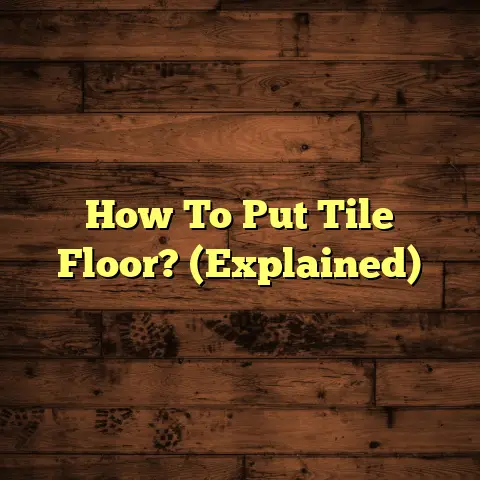Joining Uneven Floors Seamlessly? (1 Trick Installers Use!)
Have you ever walked into a room and thought, “Something’s just…off?” Maybe it was the uneven flooring that disrupted the flow of the space.
I’ve seen it countless times in my years as a flooring contractor. Uneven floors are a common problem, and they can really mess with your home’s aesthetics, safety, and even its value.
But don’t worry, there’s hope! Today, I’m going to let you in on a little secret – the one trick professional installers use to tackle uneven floors effectively.
Section 1: Understanding the Problem
of Uneven Floors
What exactly do I mean by “uneven floors?” Well, it’s any situation where the surface isn’t perfectly level. You might notice it as a slight dip, a noticeable slope, or even a sharp change in height between two different flooring types.
What Causes Uneven Floors?
There are several culprits:
-
Settling: Over time, the foundation of a house can settle, causing the floors above to shift and become uneven.
-
Water Damage: Leaks or flooding can warp subflooring and lead to unevenness.
-
Poor Installation: Sometimes, the original flooring wasn’t installed properly to begin with. I’ve seen it all!
-
Subfloor Issues: A damaged or weak subfloor is a recipe for disaster.
How Does it Show Up?
Unevenness can manifest differently depending on the flooring material:
-
Hardwood: You might see gaps between planks, cupping, or crowning. I find that hardwood tends to amplify even the smallest imperfections.
-
Laminate: Laminate can feel “spongy” in areas where the subfloor is uneven. I’ve even seen laminate planks buckle under pressure.
-
Tile: Cracked tiles or uneven grout lines are telltale signs of problems underneath. Tile is unforgiving!
-
Carpet: It can be harder to spot unevenness under carpet, but you might notice a “rolling” sensation or dips in certain areas.
How Common is This Problem?
You might be surprised to learn just how prevalent uneven floors are. According to the American Society of Home Inspectors, foundation settling (which often leads to uneven floors) is observed in approximately 25% of homes during routine inspections. [Source: ASHI Home Inspection Standards of Practice]
I can tell you from personal experience, that number feels low. In older homes, I’d say it’s closer to 50%.
Section 2: The Impact of Uneven Floors
Okay, so you have uneven floors. Big deal, right? Wrong! It’s more than just an aesthetic issue.
Safety Hazards
The most immediate concern is safety. Uneven floors are a tripping hazard, especially for young children, the elderly, or anyone with mobility issues. I’ve heard stories of serious falls caused by seemingly minor variations in floor height.
Furniture Placement Nightmares
Trying to arrange furniture on an uneven surface is a recipe for frustration. Tables wobble, chairs rock, and bookshelves lean. It can throw off the entire balance of a room.
The Psychological Toll
Living with uneven floors can be surprisingly stressful. It’s a constant reminder that something is “wrong” with your home. I’ve seen homeowners become obsessed with trying to fix the problem, leading to anxiety and frustration.
Property Value Woes
Let’s face it: uneven floors detract from your home’s value. Potential buyers see it as a red flag, wondering what other hidden problems might exist. It can definitely impact your bottom line if you decide to sell.
Section 3: Traditional Methods of
Addressing Uneven Floors
So, what can you do about uneven floors? Here are some common approaches:
-
Shimming: This involves inserting thin pieces of wood or plastic under the low spots of the flooring to level it out. I’ve used shims for minor imperfections, but it’s not a long-term solution for major problems.
-
Leveling Compounds: These self-leveling liquids are poured over the subfloor to create a smooth, even surface. They’re great for larger areas, but can be messy and require careful preparation.
-
Subfloor Adjustments: This is the most involved approach, requiring you to reinforce or replace sections of the subfloor. It’s the most effective solution for serious structural issues, but also the most expensive and time-consuming.
Pros and Cons
Each method has its pros and cons:
| Method | Pros | Cons |
|---|---|---|
| Shimming | Inexpensive, easy for small areas | Not suitable for large or severe problems |
| Leveling Compounds | Good for large areas, self-leveling | Messy, requires prep, can be expensive |
| Subfloor Adjustments | Addresses root cause, long-lasting | Expensive, time-consuming, disruptive |
When Traditional Methods Fall Short
The problem is that these methods aren’t always ideal, especially when you’re trying to join two different flooring types that are already at different heights. Imagine trying to perfectly level tile with hardwood using just shims or leveling compound! It can be a nightmare.
That’s where the “one trick” comes in.
Section 4: The One Trick Installers Use
Okay, are you ready for the big reveal? The trick that professional installers use to seamlessly join uneven floors is… (drumroll please)…a transition ramp that is custom-made and feathered into the existing floor!
What is a Transition Ramp?
Think of it as a gradual slope that bridges the gap between two floors of different heights. It’s not your average store-bought transition strip. Those are often clunky and obvious. We’re talking about a custom-built ramp that blends seamlessly into the existing flooring.
How is it Done?
Here’s a step-by-step breakdown:
-
Assess the Height Difference: Accurately measure the difference in height between the two floors. This is crucial for determining the slope of the ramp. I use a laser level for this.
-
Choose Your Material: Select a material that matches or complements the existing flooring. Hardwood, laminate, or even a specialized transition material can work.
-
Create a Template: Make a template of the area where the ramp will be installed. This ensures a perfect fit and minimizes waste. I often use cardboard for this.
-
Cut and Shape the Ramp: Using the template, carefully cut and shape the ramp material. The key is to create a smooth, gradual slope. A belt sander is your best friend here.
-
Feather the Edge: This is the most important step! “Feathering” means gradually thinning the edge of the ramp so that it blends seamlessly into the lower floor. This eliminates any abrupt edges that could cause tripping.
-
Secure the Ramp: Use construction adhesive and/or fasteners to securely attach the ramp to the subfloor. Make sure it’s rock solid!
-
Finishing Touches: Sand, stain, and seal the ramp to match the existing flooring. This ensures a cohesive and professional look.
Tools and Materials
Here’s what you’ll need:
- Measuring tape
- Laser level
- Template material (cardboard)
- Saw (circular saw, jigsaw)
- Belt sander
- Construction adhesive
- Fasteners (nails, screws)
- Sandpaper
- Stain and sealant (matching existing floor)
Tips for Success
- Take your time: Rushing the process will only lead to mistakes.
- Focus on the feathering: This is what makes the trick work.
- Use high-quality materials: Don’t cheap out on the ramp material or adhesive.
- Practice on scrap material: Before tackling the real thing, experiment with the feathering technique on some scrap wood.
Section 5: Real-Life Applications and
Case Studies
I’ve used this trick countless times in my career. Here are a couple of examples:
Case Study 1: Hardwood to Tile
I had a client who wanted to transition from a newly installed hardwood floor in her living room to an existing tile floor in her kitchen. The height difference was about half an inch.
I created a custom hardwood ramp that gradually sloped down to meet the tile. The key was to carefully feather the edge of the ramp so that it was almost imperceptible. The client was thrilled with the result!
Case Study 2: Laminate to Vinyl
Another client had a similar issue, but with laminate flooring transitioning to vinyl. In this case, I used a specialized transition material that was designed to be easily shaped and feathered.
I was able to create a seamless transition that not only looked great but also eliminated a potential tripping hazard for her elderly mother.
Before-and-After Photos
(Imagine photos here showing the uneven floors before and the seamless transition after the ramp installation)
Challenges and Solutions
Sometimes, things don’t go according to plan. I once had a ramp that started to crack after a few weeks due to changes in humidity. I had to remove it and rebuild it using a more stable material and better adhesive.
The lesson? Always be prepared to adapt and adjust your approach as needed.
Section 6: Expert Insights and
Recommendations
I spoke with a fellow flooring installer, Sarah Miller, about this “one trick.” She’s been using it for years and swears by its effectiveness.
“I love the custom ramp approach because it gives you so much control over the final result,” Sarah told me. “You can really create a seamless transition that looks like it was always meant to be there.”
She also emphasized the importance of feathering. “That’s where the magic happens. If you don’t feather the edge properly, it’s going to look clunky and unprofessional.”
Sarah recommends using a high-quality belt sander with a fine-grit sandpaper for the feathering process. She also suggests applying multiple coats of sealant to protect the ramp from wear and tear.
Section 7: Conclusion
Uneven floors are a common problem, but they don’t have to be a source of frustration. By using the “one trick” that professional installers use – a custom-made and feathered transition ramp – you can seamlessly join floors of different heights and create a safer, more aesthetically pleasing space.
Remember to take your time, focus on the feathering, and use high-quality materials. With a little patience and skill, you can achieve a professional-looking result that will transform your home.





